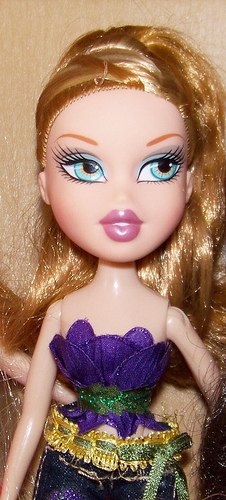 Abercrombie & Fitch, the American clothing retailer infamous for its highly sexualized and occasionally racist advertising, recently revised the description on its Abercrombie Kids‘ line of triangle bathing suit tops from “push-up” to “lightly padded.” (Watch CNN coverage of this subtle marketing shift here.) Asking why girls and pre-teens need to push up what they don’t actually have seems kind of pointless when you look at the image they’ve chosen to illustrate the swimwear line: a headless, extremely thin young woman with boobs. Nothing girlish about that body.
Abercrombie & Fitch, the American clothing retailer infamous for its highly sexualized and occasionally racist advertising, recently revised the description on its Abercrombie Kids‘ line of triangle bathing suit tops from “push-up” to “lightly padded.” (Watch CNN coverage of this subtle marketing shift here.) Asking why girls and pre-teens need to push up what they don’t actually have seems kind of pointless when you look at the image they’ve chosen to illustrate the swimwear line: a headless, extremely thin young woman with boobs. Nothing girlish about that body.
And that’s exactly the point.
These “lightly padded” string bikini tops are all about giving the illusion of boobs. Apparently this is desirable in third grade, because that’s who is being targeted. Abercrombie is a repeat offender here; in 2002, they bowed to public pressure and pulled a line of girls’ bikini and thong underwear printed with slogans like “eye candy” and “wink wink.”
It’s easy to point a finger at Abercrombie, but it’s clearly not just them. A recently released study of children’s clothes for sale in 15 popular U.S. stores found a full 30% qualified as sexualized (meaning it emphasized a sexual body part, had characteristics associated with sexiness or had sexually suggestive writing).
Why is this a problem? Well, it teaches kids that their own bodies should be judged by the narrow standards of others – according to very rigidly defined ideas of beauty and desirability. This kind of self-identification is consistently linked with depression, low self-image, low self confidence and body dissatisfaction. Kids learn that their bodies are for the pleasure of others — but only if they fit into these very strict, highly idealized parameters.
It also encourages kids to display their bodies in sexual ways years before they have the maturity, judgment and experience to handle to responses they will generate from others.
The American Psychological Association published a report in 2007 on the “broad and increasing problem of the sexualization of girls,” in which they listed the potential areas of negative fallout: cognitive and emotional consequences, mental and physical health, sexual well-being, attitudes and beliefs, impact on others and on society.
References: Goodin S et al (2011). “Putting on” sexiness: a content analysis of the presence of sexualizing characteristics in girls’ clothing. Sex Roles; DOI 10.1007/s11199-011-9966-8


2 responses to “Push-up bikini tops for 7-year-olds? Too sexy, too soon”